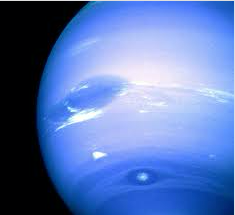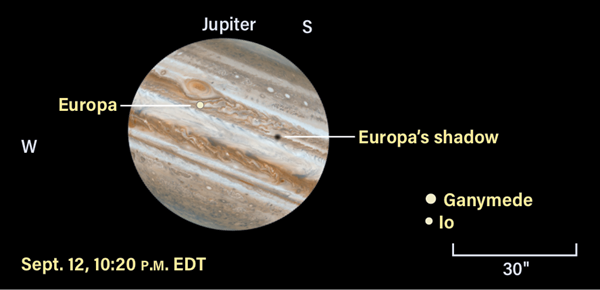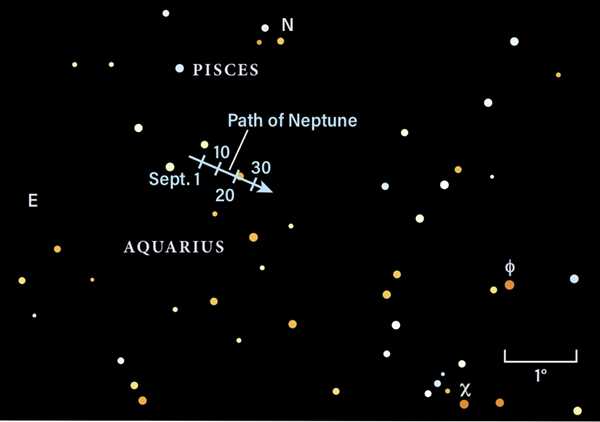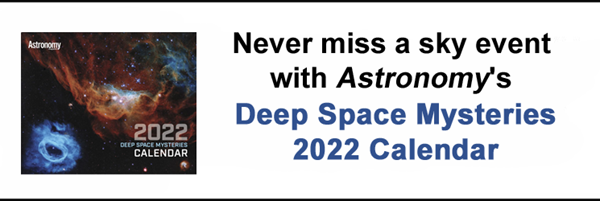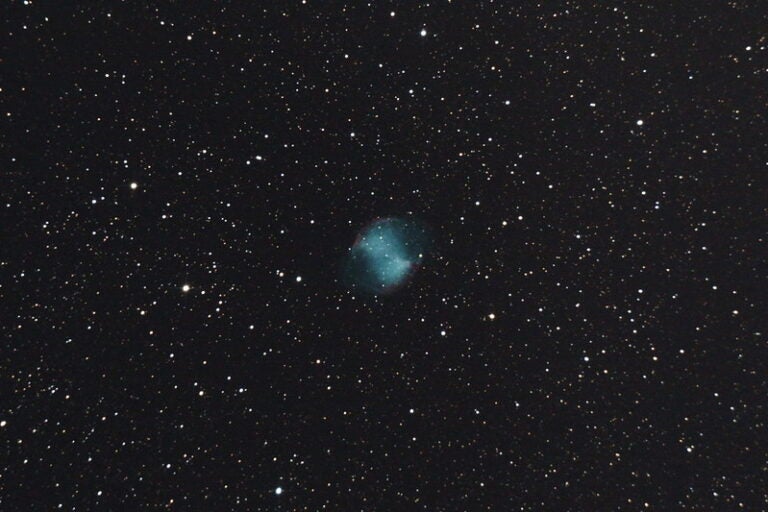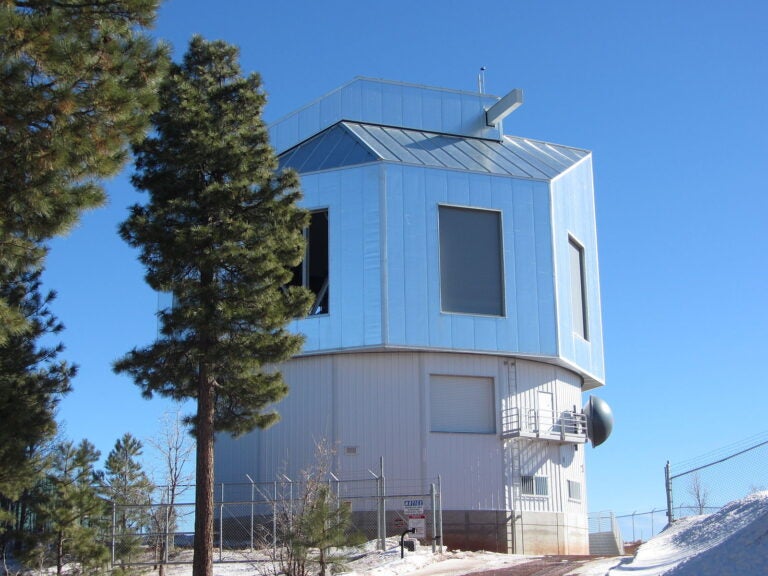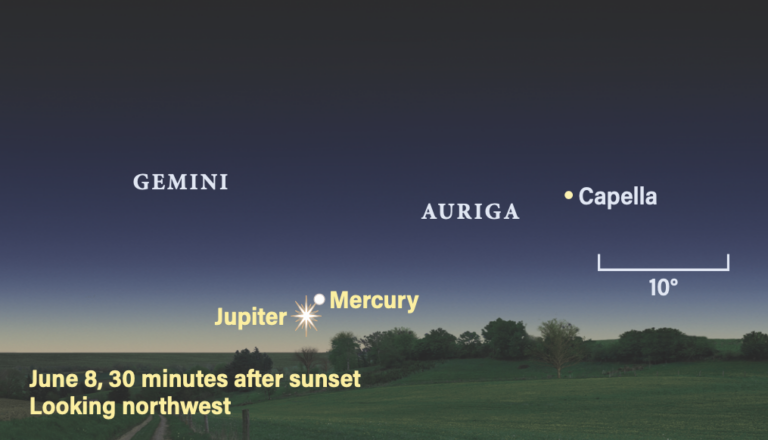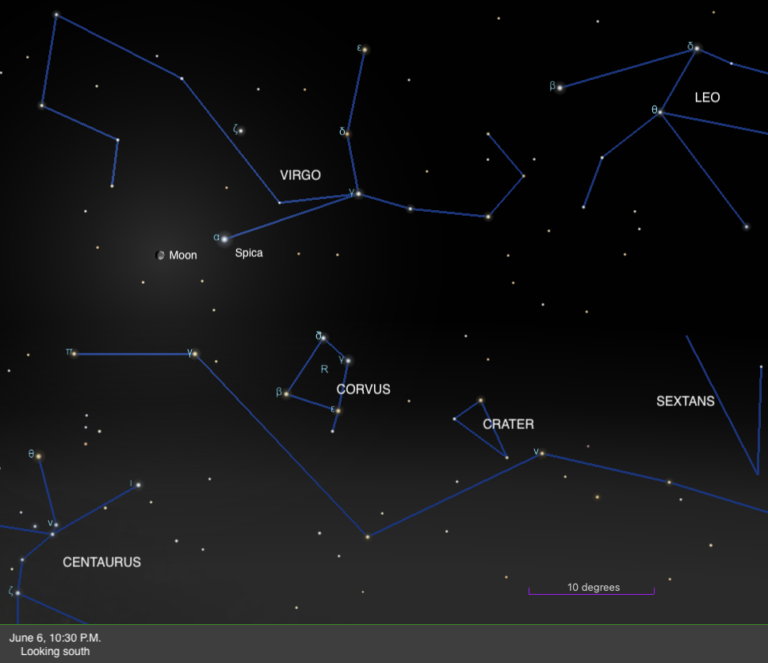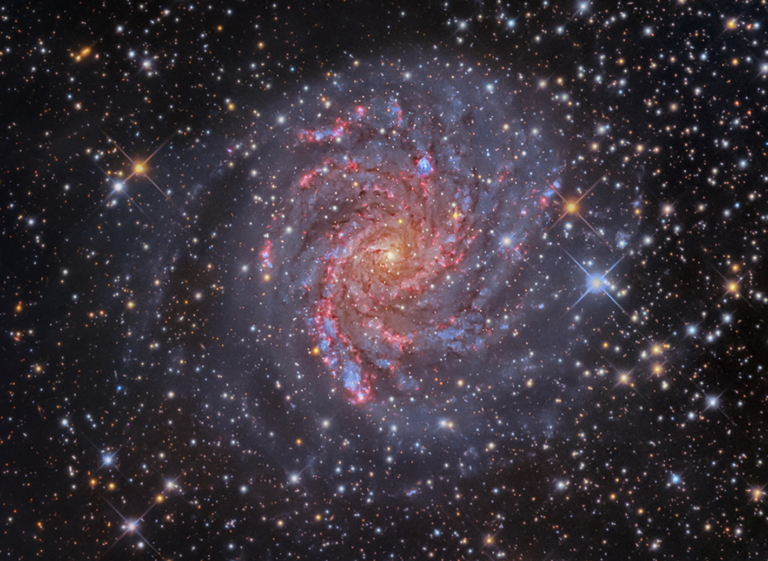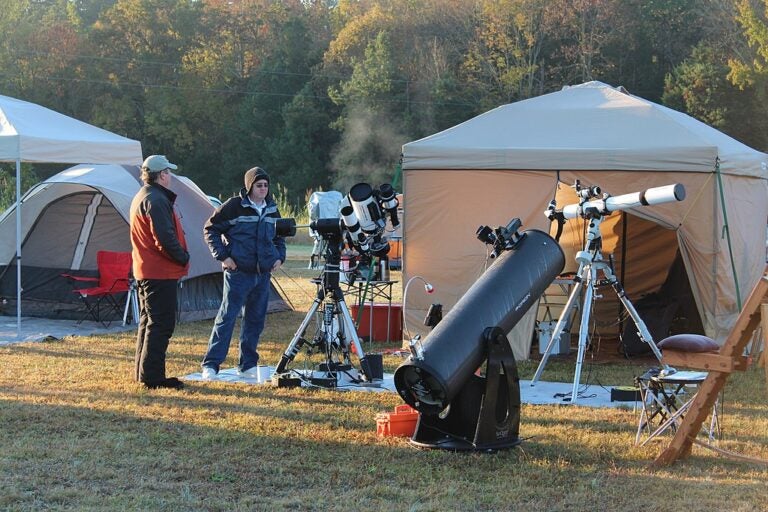Friday, September 10
Asteroid (2) Pallas reaches opposition at 10 P.M. EDT tonight. The large main-belt world is currently located in Pisces; it’s rising as the Sun sets and will be visible all night. Pallas glows softly around magnitude 8.5 — easy for binoculars or a small scope to pick up. You’ll find it about 4° south-southwest of 4th-magnitude Gamma (γ) Piscium. Pallas takes 4.6 years to circle the Sun from its location between Mars and Jupiter.
While you’re in the area, shift your gaze north of the Circlet in Pisces to find the Great Square of Pegasus: a large asterism comprising Alpha (α), Beta (β), and Gamma Pegasi, along with Alpha Andromedae. The Great Square outlines the body of the Winged Horse on the sky, while his neck arches away from Alpha Pegasi (also called Markab) toward his nose, Enif (Epsilon [ϵ] Pegasi).
Sunrise: 6:36 A.M.
Sunset: 7:17 P.M.
Moonrise: 10:36 A.M.
Moonset: 9:33 P.M.
Moon Phase: Waxing crescent (17%)
*Times for sunrise, sunset, moonrise, and moonset are given in local time from 40° N 90° W. The Moon’s illumination is given at 12 P.M. local time from the same location.
Saturday, September 11
The Moon reaches perigee — the closest point to Earth in its orbit around our planet — at 6:03 A.M. EDT. At that time, our satellite will sit 228,951 miles (368,461 kilometers) away.
Around that time (i.e., before the sky starts to grow light with the dawn) is when you’ll want to look for the false dawn, or zodiacal light, which appears before sunrise at this time of year. The best time to see it is on a clear, dark morning when there is no Moon in the sky. Look east toward the constellation Cancer, low on the horizon, and Gemini the Twins, sitting just above it. The zodiacal light will appear as a soft, delta-shaped glow thrusting upward from the horizon and stretching along the ecliptic, the plane of our solar system.
This glow is created by sunlight scattering off dust particles in the inner solar system, which are often left by comets as they skim through, throwing off dust and gases as they heat up. More recently, researchers using data from the Juno spacecraft’s trip between Earth and Jupiter discovered that some or even much of this dust could also come from the planet Mars.
Sunrise: 6:37 A.M.
Sunset: 7:15 P.M.
Moonrise: 11:50 A.M.
Moonset: 10:06 P.M.
Moon Phase: Waxing crescent (26%)
Sunday, September 12
Look south after sunset this evening to find bright Jupiter, shining at magnitude –2.8 in Capricornus the Sea Goat. The planet currently sits about 1.5° due north of 3rd-magnitude Deneb Algedi.
In locations where it’s already dark enough, zoom in on the gas giant with a telescope to see Europa begin transiting the disk at 8:26 P.M. EDT, moving from east to west. About an hour later, at 9:37 P.M. EDT, the moon’s shadow follows it onto the disk.
But there’s something else going on — look east of Jupiter to spot Io and Ganymede nearing each other. The pair floats just 30″ off Jupiter’s eastern limb, with smaller Io slightly north of larger Ganymede. Io is traveling east, while Ganymede is moving west; the two come closest at 10:20 P.M. EDT, when they sit less than 6″ apart. At that time, Europa and its shadow are both still transiting the disk.
If you’re keen to keep watching overnight, Ganymede’s westerly movement will carry it in front of Jupiter’s disk at 12:20 A.M. EDT (on the 13th, for those in the Eastern time zone). Its large shadow follows a little more than two hours later, at 2:47 EDT.
Sunrise: 6:38 A.M.
Sunset: 7:13 P.M.
Moonrise: 1:04 P.M.
Moonset: 10:46 P.M.
Moon Phase: Waxing crescent (37%)
Monday, September 13
First Quarter Moon occurs this afternoon at 4:39 P.M. EDT, about two hours after it rises. Our satellite is visible all evening, setting shortly before midnight. It’s a great night to get in some easy, enjoyable lunar observing.
Mercury reaches greatest eastern elongation (27°) at midnight EDT. It’s well below the horizon by then, though, so instead try looking for it just after sunset. It’s a bit of a challenge, because despite its position relatively far from the Sun, the ecliptic currently forms a shallow angle to the horizon. That means Mercury is not very high — by 30 minutes after sunset, the solar system’s smallest planet is only 3° high, shining at magnitude 0.2. If you’re able to turn a telescope its way, you’ll see its disk is 57 percent lit and stretches 7″ across.
Mercury currently forms the base of a line linking it with Spica — Virgo’s magnitude 1 alpha star — and Venus, shining a bright magnitude –4. Half an hour after sunset, Venus remains 11° high, setting just before 9 P.M. local time. Its 16″-wide disk is 68 percent lit and will continue to slim down slightly, ending the month about 62 percent lit.
Sunrise: 6:39 A.M.
Sunset: 7:12 P.M.
Moonrise: 2:17 P.M.
Moonset: 11:35 P.M.
Moon Phase: Waxing crescent (48%)
Tuesday, September 14
Neptune reaches opposition at 5 A.M. EDT this morning. If you happen to be up early, you can catch the solar system’s most distant planet as it slowly sets in the west amid the stars of Aquarius. The easiest way to locate Neptune is to first find 4th-magnitude Phi (ϕ) Aquarii, then skim 4° northeast of the star. Magnitude 7.7 Neptune sits near a triangle of 6th-magnitude field stars, closest to the triangle’s southwestern point. The planet’s bluish disk spans a mere 2″, but it’s visible in binoculars as a flat-looking star. If you’ve got a telescope and good seeing, you’ll likely discern some color.
Because it’s at opposition, Neptune will again rise as the Sun sets and remain visible all night, so don’t worry about missing it if you prefer to observe in the evening. Wait an hour or two after sunset for the region to climb away from the horizon, where turbulent air often muddies the view.
Sunrise: 6:40 A.M.
Sunset: 7:10 P.M.
Moonrise: 3:24 P.M.
Moonset: —
Moon Phase: Waxing gibbous (60%)
Wednesday, September 15
Look north tonight after dark and you’ll see the Little Dipper just starting to swing downward, its cup upside-down and handle curving down toward Polaris, the North Star. Over the next several hours, the Dipper’s cup will continue to rotate toward the horizon, while Polaris stays fixed above Earth’s North Celestial Pole.
The cup is formed by four stars: Beta, Gamma, Eta (η), and Zeta (ζ) Ursae Minoris. Of those, Beta (also called Kochab) is the brightest, shining at magnitude 2. Polaris, the constellation’s alpha star, is just a bit brighter. In addition to its place of honor as our current North Star, Polaris is also a Cepheid variable star, whose period — the time it takes to dim and brighten again — is linked to its intrinsic brightness. Thanks to this relationship, Cepheid variables serve as valuable standard candles that allow astronomers to measure precise distances.
Sunrise: 6:41 A.M.
Sunset: 7:08 P.M.
Moonrise: 4:22 P.M.
Moonset: 12:31 A.M.
Moon Phase: Waxing gibbous (70%)
Thursday, September 16
The Moon passes 4° south of Saturn at 11 P.M. EDT. You can enjoy the view much earlier, though — Saturn is already nearly 20° high at sunset, and another 5° higher an hour later. At that time, the Moon is just less than 5° south-southwest of the planet and will continue to inch closer in the coming hours. Both are located in southwestern Capricornus, west of where you found Jupiter the other night.
Saturn itself glows at magnitude 0.3. That’s visible to the naked eye, but you’ll want some optical aid to see its stunning ring system, which stretches out on either side of the planet’s 18″-wide disk. Those rings are tilted 19° to our line of sight, which puts their northern face on view. See if you can differentiate the duskier outer ring, called A, from the brighter Ring B. The dark gap between them is the Cassini division.
Tonight, Saturn is wreathed in several of its small moons, although our own Moon’s light may make them more challenging to see. To the planet’s southeast are Dione and Tethys, while Mimas and Rhea stand to its northwest. Enceladus sits just off Saturn’s northeastern limb, while big, bright Titan — the easiest to see at magnitude 8.5 — is nearly 3′ west of the planet.
Sunrise: 6:42 A.M.
Sunset: 7:07 P.M.
Moonrise: 5:17 P.M.
Moonset: 1:36 A.M.
Moon Phase: Waxing gibbous (80%)
Friday, September 17
Bright Vega in Lyra is the sky’s fifth-brightest star, blazing high in the eastern sky after dark tonight. Part of its secret is that it’s so close — Vega is a mere 25 light-years from Earth. But it’s also a hot class A star, which also lends it some added oomph.
But don’t let this single star outshine the constellation in which it resides. Lyra the Lyre contains several other stars, including the four — Zeta, Beta, Gamma, and Delta (δ) Lyrae — that make up its parallelogram shape. Beta Lyrae, also called Sheliak, is an eclipsing binary system with a period of 13 days. Over the course of about two weeks, Sheliak dims from magnitude 3.8 to 4.3, then brightens again. You can see this for yourself by comparing it nightly with steadier Gamma, also called Sulafat, which matches Sheliak in brightness when the latter is at its peak and shines brighter when Sheliak is dimmest.
If deep-sky observing is on your to-do list, Lyra is also home to M56, a globular cluster in the constellation’s southern region. At magnitude 8.3, binoculars or a small scope will reveal this ball of stars, which stretches about 9′ across. At its distance of more than 32,000 light-years, that corresponds to a physical diameter of about 85 light-years in space. You’ll find it 4.5° southeast of Sulafat, or 3.7° northwest of Albireo (Beta Cygni).
Sunrise: 6:43 A.M.
Sunset: 7:05 P.M.
Moonrise: 5:52 P.M.
Moonset: 2:45 A.M.
Moon Phase: Waxing gibbous (88%)

